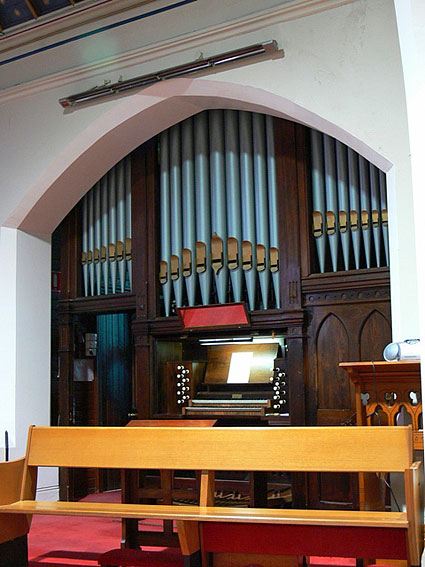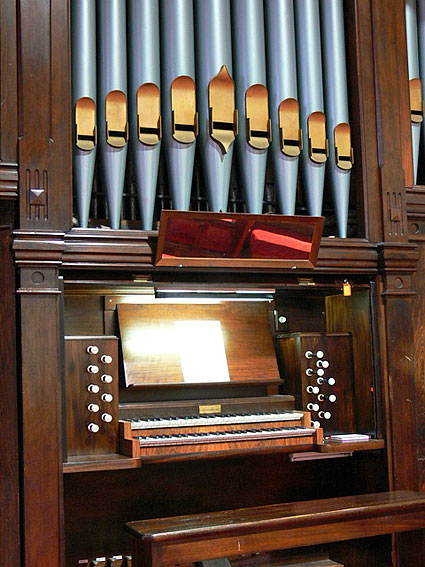Christ Church Anglican Church
Warrnambool
First organ: B. 1868 George Fincham.
Moved 1874 to a new position in the church, then to organ chamber 1889.
Sold 1890 to Major Helpman at the Orderly Rooms, Warrnambool.
Sold 1891 to Warrnambool Congregational Church.
Moved to Congregational (later Uniting) Church, Hughesdale 1939.
Moved 2008 to St Michael and All Angels Anglican Church, Talbot.
Present organ:
B 1890 Fincham & Hobday; reb 1976 Geo Fincham & Sons. 2m, 17spst, 3c, tr. Gt:
8.8.8.4.4.2.III. Sw: 16.8.8.8.4.2.III.8. Ped: 16.16.


The foundation stone of the present Christ Church was laid on 3 December 1855. It was built to the design of English-trained architect Nathaniel Billing, who had been a pupil of Gilbert Scott. The stone porch was added in 1859 and the north nave in 1861, the consecration by Bishop Charles Perry following on 19 December 1862. The chancel was completed in 1877. This produced a building with two parallel naves, not unlike the church of St Helen, Bishopsgate, London. The tower was added in 1882, to the design of Terry & Oakden, but without the intended spire. The church is in the Early English Gothic style and built from sandstone; it is situated in an attractive churchyard behind stone walls. It includes many fine fittings including excellent stained glass, some from Ferguson & Urie, of Melbourne, and stencilled and gilded panels in the sanctuary dating from 1871.
The first pipe organ was built in 1868 by George Fincham. This was moved in 1874 to a new position in the church and then to an organ chamber in 1889. The instrument was sold in 1890 to Major Helpman at the Orderly Rooms, Warrnambool and in 1891 to the Congregational Church in that city. It then went to the Congregational (later Uniting) Church, Hughesdale in 1939 and was moved in 2008 to St Michael and All Angels Anglican Church, Talbot.
The present organ was built in 1890 by Fincham & Hobday at a cost of £609 5s less £100 for the old organ; it was opened on 7 December 1890. It was placed in the organ chamber, to the right of the chancel, under a low arch. A contemporary description in the Warrnambool Standard noted:
“Too much praise cannot be given to the builders of this excellent instrument. In consideration of the position which it occupies, the pipes have been “voiced” extra loud, but, necessarily, its full power is not so observable as might be the case were it fairly in the church, and diverse expedients have been resorted to by the builders to make the most of the resources of the instrument. The church has to be congratulated upon securing an organ, combining in a relative scale all the characteristics of the emperor of instruments. It produces at once a smooth, equal and uniform sonorousness, blending with a sweetness of articulation not often noticed in a new instrument. The soft stops are really delightful, whilst the diapasons reply with remarkable precision to the twisted and tangled phrases, pursuing and rolling over one another, each as were exemplified in the Giant Bach fugue of last night. The test to which the organ was subjected also testifies to the workmanship displayed in its construction, and to the care and ability entrusted to Mr. George Collings, to whom Messrs. Fincham and Hobday entrusted the task of setting it up. The firm in question have now three organs in Warrnambool, and they certainly may be felicitated upon the success attending, the purity of tone and quality or workmanship accompanying each of them.”
A rebuilding by George Fincham & Sons Pty Ltd took place in 1976. At this time, a new console was installed, the mechanical action upgraded, the façade pipes repainted over the original decoration, and a new Mixture III installed on the Great Organ in place of the original Twelfth. The instrument is of interest for the rare pairing of Gemshorn stops on the Swell at 4 and 2ft pitches – the latter harmonic. This derived from the Choir Organ of the 1872 Hill & Son organ at Melbourne Town Hall and was also utilized in 1890 for the Choir Organ at the Australian Church, Melbourne.
GREAT |
8 8 8 4 4 2 III 16 8 8 8 4 2 III 8 16 16 |
(originally Twelfth 2-2/3) # # # |
# operated by toe pedals 1976
Compass: 56/30
3 composition pedals to Great
3 composition pedals to Swell
Balanced swell pedal (originally lever pedal)
Attached drawstop console
Mechanical key & Stop action

|
||
 |
 |
|
 |
 |
|

|
||
Photos: JRM (Oct. 2008)
W.J. Pinson, Christ Church “The English Church” Warrnambool 1847-1987. Warrnambool: Christ Church Vestry, 1987
Victorian Churches, edited by Miles Lewis. East Melbourne: National Trust of Australia (Victoria), 1991, p.153
E.N. Matthews, Colonial Organs and Organbuilders. Carlton: Melbourne University Press, 1969, p.178
John Maidment
17 October 2008